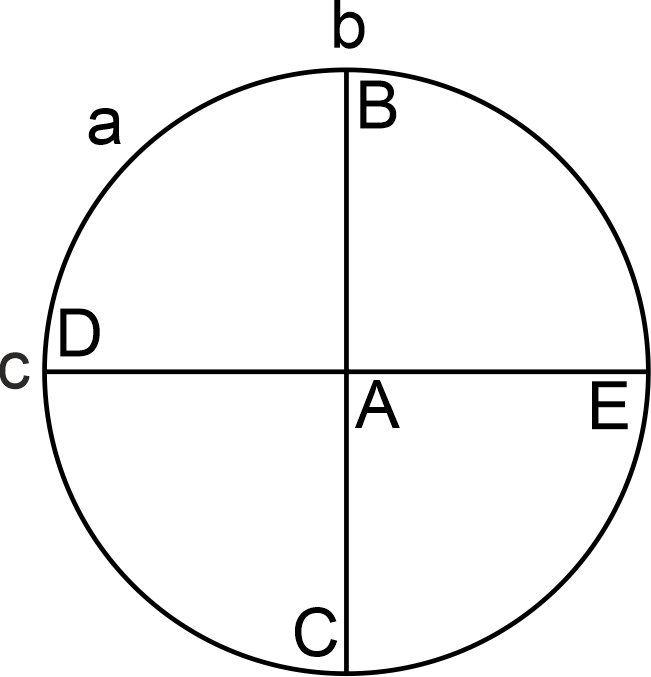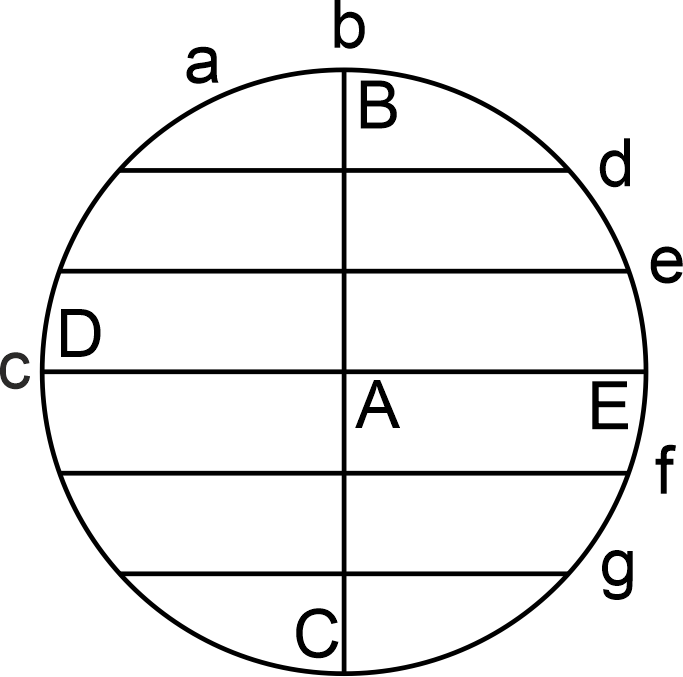- Title: Contemplations, The Cross in the Circle: Consciousness and Duality.
- Author: Arvindus.
- Publisher: Arvindus.
- Copyright: Arvindus, 2015, all rights reserved.
- Index: 201510131.
- Edition: html, first edition.
§
The cross in the circle is a well known astrological symbol of the earth1 and is only therefore already interesting to be contemplated. This shall be done in the present contemplation, though not from an astrological perspective. In this contemplation shall the cross in the circle be contemplated, as the title already indicates, from the perspective of consciousness and duality.
Let us start by taking a look at the cross in the circle as the geometrical figure it is. In figure 1 we see that the cross in the circle basically consists of two lines and a circle or of three lines. There is one circle (also understandable as a circular line) (a), one straight vertical line (b) and one straight horizontal line (c). The crossing of these lines make the figure contain five points. One in the middle (A), one at the top (B), one at the bottom (C), one left (D) and one right (E).

Figure 1.
Now when we take point A and circle a in consideration we can recognize the point in the circle.2, 3 In this symbol do the point and the circle represent subjectivity and objectivity, the microcosm and the macrocosm or man and his world.
But point A is not just placed within a circle, it is also placed in between four points. On the vertical line b point A is placed between the points B and C. This makes a triplicity of points where A is placed in the middle of the upper B and the lower C. Now such a placement of givens resembles the triplicity of spirit or life, soul or consciousness and matter or body.4 In this does point A take as consciousness the middle position between the duality of spirit as point B and matter as point C.
Point A however does not only take a middle position on the vertical line b but also on the horizontal line c. For there it is the middle point between the left point D and the right point E. And such a placement of givens resembles the triplicity of two poles with their point of balance on a same plane.5, 6
Now as consciousness occurs between subjectivity and objectivity or between man and his world, symbolized by the point in the circle, we see this symbol of consciousness further worked out in the cross in the circle. Man's subjectivity stands between his spirit and his body but it also stands between the perceived duality of the objective plane on which he is conscious.7
The question may rise what plane the in figure 1 depicted vertical line c represents. To answer this question first a look needs to be given at the different planes. From high to low there are seven, namely the divine, the monadic, the atmic, the intuition or buddhic, the mental, the emotion or astral, and the physical plane.8 Now since horizontal line c is placed exactly in the middle between the highest and the lowest plane it may dawn that it must represent the middle plane, which regards the buddhic or intuition plane. And this makes sense. For the intuition is the soul or consciousness principle par excellence.9 Thus it is sane to consider the horizontal line of the cross of consciousness as representing the plane of the intuition.
Between the buddhic plane and the highest plane there are however two other planes, as there are also two planes between the buddhic plane and the lowest, and it might be of interest to enrich the cross in the circle with the representing lines for these planes.

Figure 2.
In figure 2 we again see the circle or circular line a, the vertical line b and the horizontal line c, representing the buddhic or intuition plane, however we now also see the horizontal lines d, e, f and g representing the monadic, atmic, mental and emotion plane. There is also a divine plane and a physical plane. These however are not represented by lines but by points (B and C) at the top and the bottom. That these latter two planes are represented by points instead of lines shows that on these levels there is no consciousness of duality. Even more; there is no consciousness at all since the latter always goes hand in hand with a certain sense of duality.
What then are the dualities that man is conscious of on the other planes? Let us go from the bottom of figure 2 upwards. The first plane we encounter was already mentioned as the physical plane at point C. When man is fully identified with his physical nature there is no consciousness and no sense of duality. Man would in such a case purely follow the activity inherent in the matter of which his body is composed.
Line g represents the emotion or astral plane, being placed directly above the physical plane. This being the emotion plane man, when identified with his emotions, is conscious of emotional dualities. Of these the duality of pleasure and pain is probably the most primal. That line g is relatively short means that the dualities found at both endings of the line are less outspoken than those found on longer lines. But it also means that the consciousness is less outspoken. For the maximum of consciousness is found at the point where the lines of the cross are the longest and where thus the dualities are the most outspoken.
Line f is longer than g, and this line represents the mental plane. When man is identified with his mental apparatus he is more conscious than when identified with his emotions, and the dualities of the mental plane, which regard those of meaning, are more outspoken. The duality of truth and falseness is probably the most primal one found on this plane.
Line c above line f is the longest horizontal line of figure 2. This is the line that represents the buddhic or intuition plane. That this line is the longest means that man's consciousness is the widest on this plane. But the dualities here are also the most outspoken. One could say that on this plane man is conscious of good and evil.
The lines above line c need no elucidation here. Most of us are still struggling on the planes of emotion and mind and the dualities of the atmic plane can not be sensed yet. Perhaps the dualities there shall have to do with the duality of unity and multiplicity. But we are not quite there yet.
There can however something be said about the horizontal lines becoming shorter above the line representing the intuition plane. For one may be surprised to see the consciousness becoming less towards the spiritual pole. This is because from the plane of intuition where the apex of consciousness is reached man more and more transcends consciousness, identifying himself with being. Where at the lowest point of the identification with matter man is unconscious in non-being there man transcends consciousness in the pure being of spirit.
May we thus after reaching our apex of consciousness come to reside in pure being.
Notes
- Marion D. March & Joan McEvers, The Only Way to Learn Astrology, Volume I, Basic Principles, Astro-Analytic Publications, San Diego 1993, p. 4.
- 'Contemplations, An Esoteric Interpretation of Rembrandt's Philosopher in Meditation ', Index: 201307081, Geometrical Symbolism, The Point in the Circle.
- 'Contemplations, A Setup for a Metaphysicratic Manifest', Index: 201204032, Metaphysicality.
- 'Ageless Wisdom, Triplicities in Man', Index: 201308292.
- 'Contemplations, 'Sister' and 'Brother'', Index: 201502241.
- 'Ageless Wisdom, Man on the Planes', Index: 201212031.
- Nota 5.
- 'Ageless Wisdom, Man on the Planes', Index: 201212031.
- Nota 4.
Bibliography
- 'Ageless Wisdom, Man on the Planes', Index: 201212031.
- 'Ageless Wisdom, Triplicities in Man', Index: 201308292.
- 'Contemplations, An Esoteric Interpretation of Rembrandt's Philosopher in Meditation ', Index: 201307081.
- 'Contemplations, A Setup for a Metaphysicratic Manifest', Index: 201204032.
- 'Contemplations, 'Sister' and 'Brother'', Index: 201502241.
- Marion D. March & Joan McEvers, The Only Way to Learn Astrology, Volume I, Basic Principles, Astro-Analytic Publications, San Diego 1993.